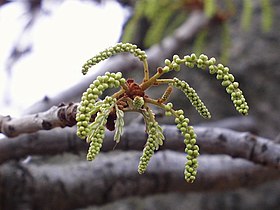Burkea africana
| Wild syringa | |
|---|---|

| |

| |
| Summer and autumn foliage | |
| Scientific classification | |
| Kingdom: | Plantae |
| Clade: | Tracheophytes |
| Clade: | Angiosperms |
| Clade: | Eudicots |
| Clade: | Rosids |
| Order: | Fabales |
| Family: | Fabaceae |
| Subfamily: | Caesalpinioideae |
| Genus: | Burkea |
| Species: | B. africana
|
| Binomial name | |
| Burkea africana | |
Burkea africana, the wild syringa (Bambara: siri), is a deciduous, medium-sized, spreading, flat-topped tree belonging to the subfamily Caesalpinioideae of the family Fabaceae. The genus was named in honour of Joseph Burke, the botanist and collector.
Range[]
Widespread in tropical Africa, it is found in Chad, Sudan, Tanzania, Uganda, Cameroon, the Central African Republic, Zaire, Benin, Burkina Faso, Ivory Coast, Ghana, Guinea, Mali, Niger, Nigeria, Senegal, Togo, Angola, Malawi, Mozambique, Zambia, Zimbabwe, Botswana, Namibia and South Africa in the Transvaal region.
Description[]
Leaves are bipinnately compound, silvery pubescent or glabrescent. Flowers are creamy white, fragrant and in pendulous racemes of up to 300 mm in length. The bark is toxic, rich in alkaloids and tannins and used for tanning leather. Pulverised bark is thrown into water to paralyse fish.
Uses[]
If cut from the heartwood, it produces durable, insect-resistant timber with a moderately fine, wavy grain which is dark brown to reddish brown, and is used for parquet flooring and fine cabinet and furniture work.
Food plant[]
The foliage is browsed by the larvae of two Saturniidae moths, Rohaniella pygmaea and Imbrasia forda.

Flower buds 
Seed pods 
Foliage
External links[]
- Burkea africana in West African plants – A Photo Guide.
- "Burkea africana". PlantZAfrica.com. Retrieved 2010-02-10.
- Caesalpinioideae
- Flora of Africa
- Flora of Ivory Coast
- Plants described in 1843
- Caesalpinioideae stubs


